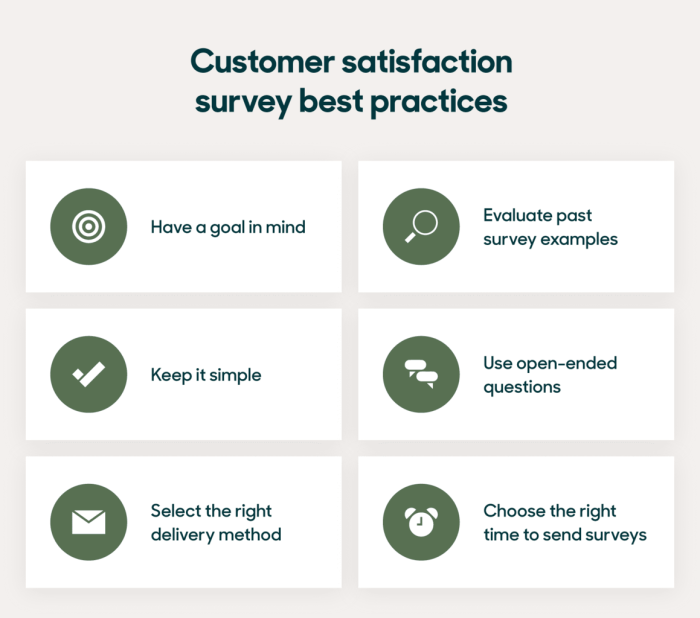Best Practices for Customer Surveys dives into the world of gathering valuable feedback through engaging surveys, shedding light on effective strategies and methods for maximizing insights and customer satisfaction.
Importance of Customer Surveys
Customer surveys are a crucial tool for businesses to gather valuable feedback from their customers. This feedback helps in understanding customer preferences, identifying areas for improvement, and enhancing overall customer satisfaction.
Improving Products or Services
Customer surveys play a vital role in improving products or services by providing direct insights from the customers themselves. Companies can identify what customers like or dislike about their offerings, what features they value the most, and areas where they can make enhancements.
- By analyzing survey responses, businesses can make informed decisions on product development or service modifications.
- Feedback from surveys can help in addressing customer pain points and enhancing the overall customer experience.
- Companies can prioritize features or services based on customer feedback, leading to more tailored and customer-centric offerings.
Examples of Successful Companies
Amazon
Amazon is known for its extensive use of customer surveys to gather feedback on its products and services. This feedback loop allows Amazon to continuously improve its offerings based on customer preferences and demands.
Apple
Apple utilizes customer surveys to gather insights on user experience with its products. This feedback helps Apple in refining its products and developing new features that cater to customer needs and expectations.
Starbucks
Starbucks leverages customer surveys to understand customer preferences in terms of coffee flavors, store ambiance, and service quality. This feedback helps Starbucks in maintaining customer loyalty and enhancing the overall coffee shop experience.
Designing Effective Survey Questions
When it comes to crafting survey questions, there are a few key characteristics to keep in mind to ensure your survey is effective in gathering valuable insights from your customers.
Avoiding Bias in Survey Questions
Bias in survey questions can lead to skewed results, so it’s crucial to formulate questions in a way that eliminates any potential biases. Here are some tips to help you avoid bias in your survey questions:
- Avoid leading questions that steer respondents towards a particular answer.
- Avoid loaded questions that contain emotionally charged language.
- Avoid double-barreled questions that ask about more than one issue at a time.
- Use neutral language that does not sway respondents in any direction.
Creating Clear and Concise Survey Questions
Clarity and conciseness are essential when it comes to survey questions to ensure that respondents understand what is being asked of them. Here are some tips for creating clear and concise survey questions:
- Avoid using jargon or technical language that may confuse respondents.
- Keep questions simple and to the point, avoiding unnecessary complexity.
- Use a mix of open-ended and closed-ended questions to gather a variety of responses.
- Ensure that each question is relevant to the overall goal of the survey.
Choosing the Right Survey Method

When it comes to conducting customer surveys, selecting the right survey method is crucial for obtaining accurate and valuable feedback. Different survey methods have their own set of advantages and limitations, so it’s essential to choose the one that best suits your target audience and research objectives.
Comparing Various Survey Methods
- Online Surveys: Online surveys are cost-effective and offer the convenience of reaching a large number of respondents quickly. However, they may not be suitable for all demographics, especially older populations who may not be as tech-savvy.
- Phone Interviews: Phone interviews allow for a more personal interaction with respondents and can be effective for gathering detailed feedback. Nevertheless, they can be time-consuming and expensive.
- In-Person Surveys: In-person surveys provide an opportunity for face-to-face interaction, which can lead to more in-depth responses. On the downside, they are labor-intensive and may have limited reach.
Pros and Cons of Different Survey Distribution Channels
- Online Surveys: Pros include cost-effectiveness and quick response rates, while cons may include potential bias from self-selection and limited access to certain demographics.
- Phone Interviews: Pros involve personal interaction and detailed feedback, but cons include higher costs and potential response bias due to phone call interruptions.
- In-Person Surveys: Pros consist of in-depth responses and personal connection, while cons include labor-intensive data collection and limited reach.
Guidelines for Selecting the Most Suitable Survey Method
- Consider the demographics of your target audience and their preferred communication channels.
- Assess the level of engagement required for your survey and choose a method that fosters meaningful interaction.
- Evaluate the budget and resources available for conducting the survey to determine the most cost-effective approach.
Increasing Survey Response Rates: Best Practices For Customer Surveys

To boost survey response rates, it is essential to implement strategies that engage participants and make it easy for them to provide feedback. Survey timing plays a crucial role in maximizing responses, as reaching out to customers at the right moment can significantly impact their willingness to participate. Incentivizing participants is another effective way to encourage completion of surveys.
Utilize Multiple Communication Channels, Best Practices for Customer Surveys
Utilize various communication channels to reach a wider audience. Send out surveys via email, social media, and even text messages to ensure that customers have multiple opportunities to respond.
Keep Surveys Short and Simple
Design surveys that are short, concise, and easy to understand. Customers are more likely to complete a survey if they know it won’t take up too much of their time. Avoid overwhelming participants with lengthy questionnaires.
Offer Incentives
Provide incentives such as discounts, coupons, or entries into a prize draw for customers who complete the survey. Incentives can motivate participants to take the time to provide valuable feedback.
Follow Up with Reminders
Send out reminder emails or messages to customers who have not yet completed the survey. A gentle nudge can prompt participants to finish the survey they may have forgotten about.
Personalize Survey Invitations
Personalize survey invitations by addressing customers by their name and mentioning specific interactions they’ve had with your business. This personal touch can make customers feel valued and more likely to respond.
Analyzing and Utilizing Survey Data
When it comes to analyzing and utilizing survey data, businesses must follow a systematic approach to extract valuable insights that can drive decision-making and improve customer experience.
Effective Analysis of Survey Data
- Organize the data: Start by organizing the survey data in a structured manner to easily identify patterns and trends.
- Use data visualization tools: Utilize charts, graphs, and other visual aids to present the data in a more understandable format.
- Identify key metrics: Focus on key metrics such as customer satisfaction scores, Net Promoter Score (NPS), and customer loyalty indicators.
- Compare results: Compare survey results over time to track changes and improvements in customer feedback.
Interpreting Survey Results
- Look for patterns: Identify common themes or patterns in the survey responses to understand customer preferences and pain points.
- Analyze open-ended responses: Pay attention to qualitative feedback to gain deeper insights into customer opinions and suggestions.
- Segment the data: Segment the survey data based on demographics, purchase behavior, or other relevant factors to tailor strategies accordingly.
- Draw actionable insights: Translate survey results into actionable insights that can be implemented to enhance customer satisfaction and loyalty.
Utilizing Survey Data for Enhanced Customer Experience
- Personalization: Use survey data to personalize customer interactions and tailor products or services to meet specific needs.
- Product/service improvements: Implement changes based on survey feedback to enhance the quality of products or services offered.
- Customer retention strategies: Develop customer retention strategies by addressing issues highlighted in the survey responses.
- Continuous improvement: Continuously analyze survey data to identify areas for improvement and ensure ongoing enhancement of the customer experience.





